5 Ways to Successfully Fail in Hollywood
Turn your mishaps into movie moments.
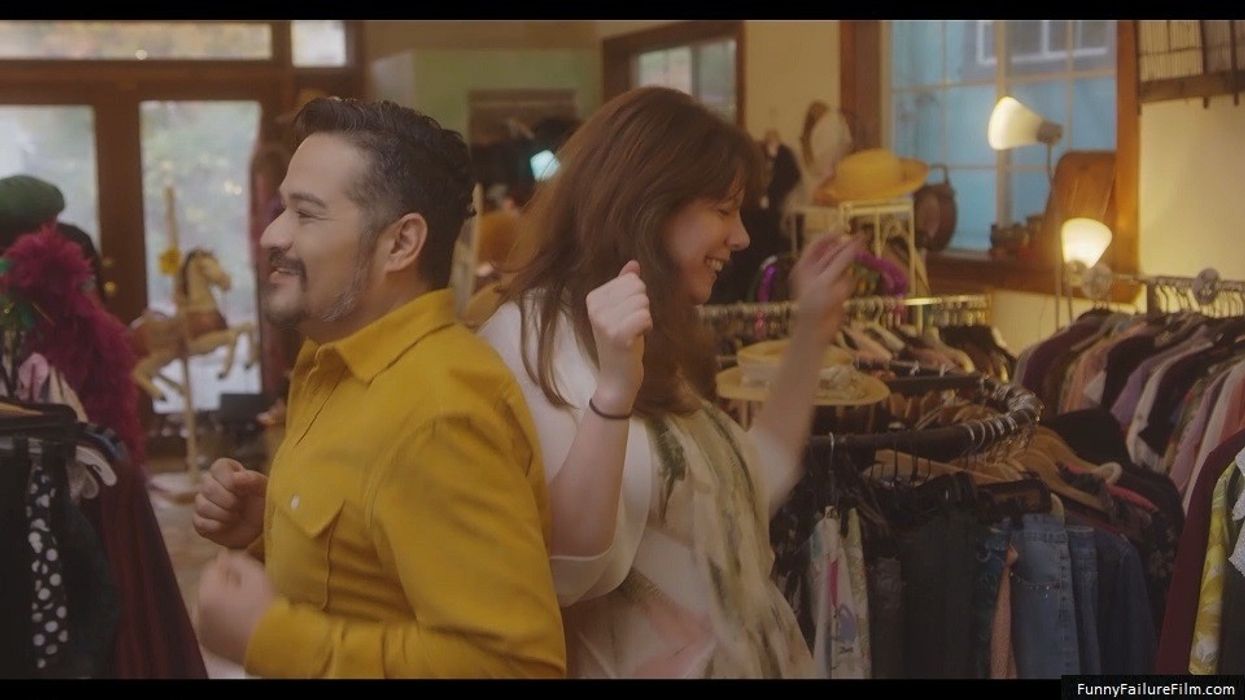
Adrian Gilbert as Ben and C.M. Conway as Ellie in 'How to Successfully Fail in Hollywood'
This post was written by C.M. Conway.
Whenever I casually mention in conversations I pursued a career in Hollywood as an actress first, I receive the same reaction: an awkward pause.
Sometimes the silence is filled with excited curiosity. Sometimes pity. Sometimes, I allow the silence to continue as long as humanly possible. I bake in it, letting the information sit there, like a cake right out of the oven.
Who wants to take the first bite?
I’ll cut the suspense—I did not succeed in Hollywood as an actress. In fact, I successfully failed in terms of industry standards. But hey, with about 85 percent of actors unemployed or unable to make a living at any given time, I’m in good company. Yet the process of writing a screenplay, and then making a witty and poignant feature film inspired by my mishaps taught me how to flip failure.
One only has to peek at the many videos on popular platforms with millions of views featuring fails. Experiencing the bone-crushing, flat-faced falls of others seems like the new pastime based on the almighty algorithm. Schadenfreude anyone?
But an amazing thing happened from the experience of not obtaining my initial dream. A few years after I moved out of Los Angeles, I felt haunted by it. So much so, I had to write about it to get it out of my system. Then, I suddenly started seeing the humor in all of it. I was trying to be a serious actress but didn’t realize I was in a comedy the entire time.
Once I completed the screenplay, something in me felt I could make it a feature film (my first). I can’t explain it, but on some level, I knew I’d been preparing for this my entire life.
To my surprise, my film How to Successfully Fail in Hollywood became the little indie that could and is now on a top streaming giant.
Our movie follows Ellie, a bottom-feeder actress at the end of her rope in Hollywood when a life-changing event happens with her gay, Latinx friend Ben. A surreal twist unfolds, as she unwittingly becomes the key to a new take on Tinseltown where failure is the star.
Ellie and Ben are actors trying to make it against all odds on their terms while navigating truth, fantasy, and identity in outrageous Hollywood. All while having fantastic flubs along the way. Sound familiar?
I essentially created a fun “how-not-to” guide--a quintessential outsiders look inside Tinseltown, with the freedom to share a treasure trove of its inner secrets without fear since I wasn’t famous. I was the expert after all, and created a film dedicated to all the unknown bold artists and dreamers who comprise most of the industry itself.
These secrets also crossover to other artistic trades in entertainment, since most arts industries have a similar pyramid model. That is, a group of wildly successful artists on top, and an enormous group of struggling artists supporting the top triangle (or at least trying to make a living at their craft).
Films and filmmakers are not immune to this dynamic. In an IFTA video last year, Peter Klass, Partner at GHJ (film contracts, audit, and accounting services) said approximately “80 percent of films are not profitable.” The rate is likely higher for unknown indie filmmakers.
Time to remake this model. Are you in?
Our film reveals that underneath all the rosy tales touting success in Hollywood, hides the crucial information of what not to do, all the pitfalls and pratfalls. That's where the real gold is buried in Tinseltown and it was time to unearth the treasure.
I realized when making the movie, as filmmakers we also must embrace bodacious blunders if we have any shot of making something seminal and beating the odds. With a bevy of commercial and formulaic films being churned out, the real risk-takers and artists are savvy to the fact that slip-ups are stepping stones to where the gold resides and pave the way for something greater.
To guide the way, here are five tips to flip failure as a filmmaker.
1. Mine the Gold
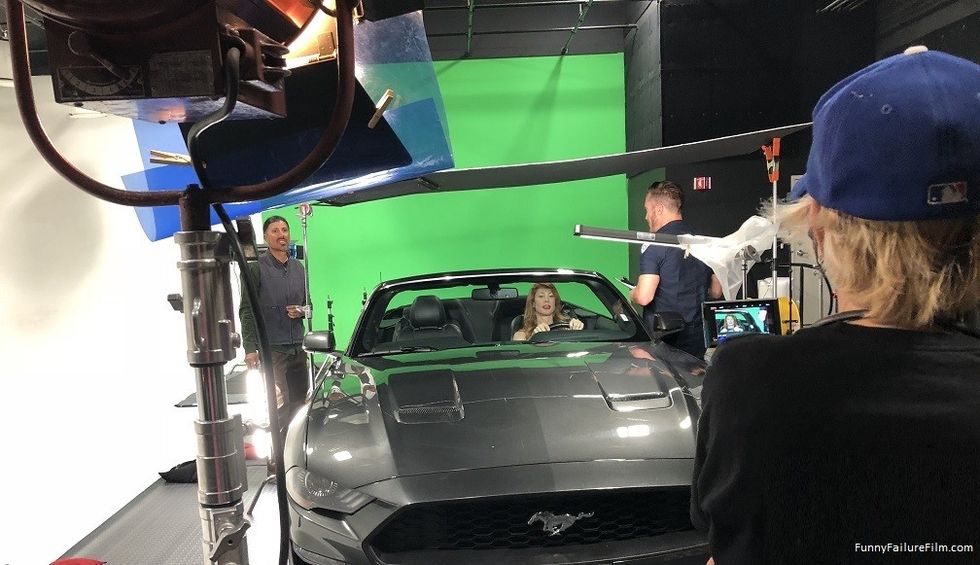
Eduardo M. Cuevas, Janet Lynn Saunders, Ryan Williams and Lisa Stoll (Cinematographer)
Credit: Showstoppers
Nothing cuts to the bone quite like failure. It’s like a brutally honest friend who doesn’t care how you feel. Not getting what you want stings, yet failure presents enormous opportunities if you only look.
If doors are consistently slamming in your face when going down a particular avenue in filmmaking, try again. If that doesn’t work, try another way. Keep trying to find a combination of what works until you start to feel the elements coalescing together. Remember, what works for someone else may not work for you.
For example, I live in the North Bay, California. We had a super-micro budget for our film and decided to tap owners of local businesses in Sonoma County and the Bay Area (in addition to L.A.) to request filming in their location. We also had an opportunity and filmed in front of the Hollywood Sign, which was a dream come true. (Fun fact: if you want to use the Hollywood Sign in your movie, you need to contact the Hollywood Chamber of Commerce. It’s an iconic symbol, and they’re nice people.)
The community support for our film was inspiring and a crucial lynchpin, and, in the end, became a grassroots movement with the added benefit of getting the word out about our film. We also helped get the word out about the local businesses that supported our film and mission of diversity, gender equity, and inclusivity. As a consultant in marketing, my background became invaluable with the press interested in covering these aspects of our indie, among others.
All because we didn’t have a big budget and had to get creative.
2. Flip the Script
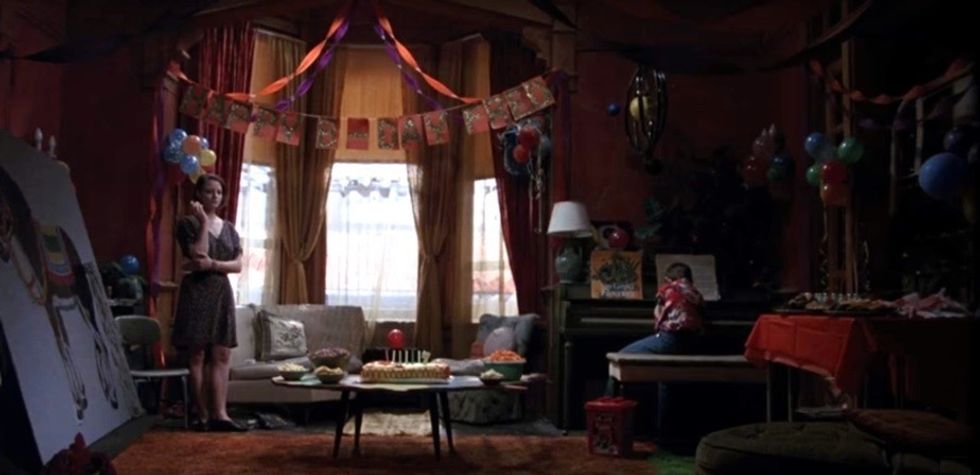
Jodie Foster and Adam Hann-Byrd, 'Little Man Tate'
Credit: MGM
Having challenges in various aspects of filmmaking? Whatever stage you’re in, it’s never too late to flip the script. This was the term Noah Abrams, a reporter for NPR (KRCB affiliate) used in an interview when describing the process for our film. Harry Duke (host for "The Drive" on KSRO) put it succinctly when he said our film was an example of transforming failure into success in filmmaking.
The bottom line is what you do about failure determines its outcome.
Flipping the script and seeking a solution outside the box when a mistake occurs is an invaluable trait as a filmmaker, especially when you need to find a resolution on the fly. As filmmakers, we need to be very agile to know when to cheat a shot, get more coverage, or feature a prop in an interesting way that tells a story.
One of our actors accidentally left his wedding ring on in a scene and his character is divorced. We didn’t realize it until after filming all his shots. So, we decided to film him in another scene taking it off at a pivotal moment, as a statement he’s moving on.
When daylight is fading and you have to get the shot, creativity is crucial. Jodie Foster illustrated this beautifully when discussing directing, Little Man Tate. They didn’t have time on a particular shoot day to do close-ups of the mom and her son in a birthday scene. So, they just filmed the master shot in a take. She said the scene came across with a quality of detachment between the characters that worked well for that point in the story.
3. Turn the Sail
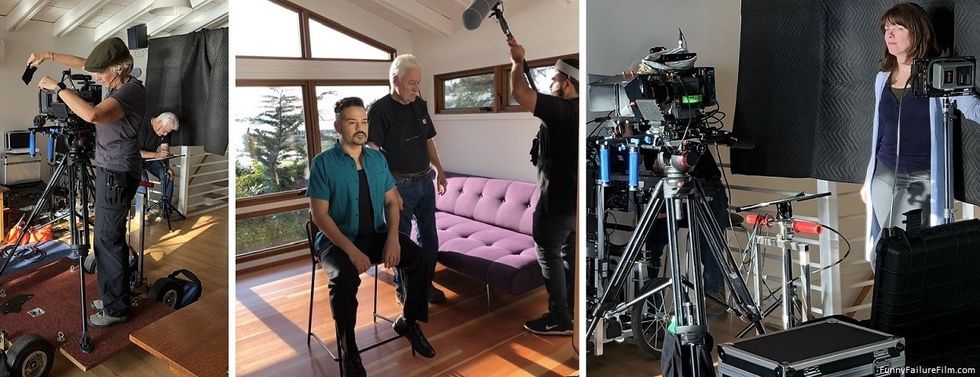
Behind the Scenes: Lisa Stoll (Cinematographer), Adrian Gilbert (Actor), Daniel Hess (Sound Recordist), and Gary Baca (Boom Operator)
Credit: Showstoppers
Failure often shows you where or when to turn the sail on your boat to avoid a shipwreck.
So, it’s important to look at why a failure occurred. Do you need to stay the course, stay still, or move in another direction entirely? This takes astute observation to sense the signals. Sometimes, the signals repeat until you get it. It’s all information on your own hero or heroine’s journey.
As much as I’ve experienced doors slamming in my face in Hollywood as an actress, I was amazed at the remarkable momentum that occurred when I decided to take the reins and sit in the driver’s seat. In writing, directing, executive producing, and editing my first movie in all roles (while costarring with actor Adrian Gilbert), I was using all of my skills that I learned from acting.
All those years watching the Director’s Commentary on movies didn’t hurt either. I also couldn’t have done it without enormous preparation and the hard work of our cast, skeleton crew, and the support of my husband, family, friends, crowdfunding donors, and the local community. The timing was impeccable because we wrapped filming just before the pandemic hit. When that little voice in you says go… go!
If you fall on your face, just remember the greats have had great failures, but the art they created from them will remain.
USC Film School rejected a young Steven Spielberg three times. Spielberg was also devastated by the reception and reviews of his 1979 comedy 1941 after the big success of Jaws and Close Encounters of the Third Kind.
Oprah Winfrey stated she went into a depression after the Beloved box office failure, but she also said, “I don't believe in failure. It is not a failure if you enjoyed the process.”
Barry Jenkins described to Vanity Fair trying to find the right score with composer Nick Britell to “excavate meaning for a confounding scene” in his Academy Award-winning film Moonlight, saying, “Constructivism had failed us; building a piece from the remnants of other shapes and sounds from the score had failed, and finally, as I sat behind him, Nick opened with tremolos and then just…went… It was a moment of pure feeling. I will never forget it.”
Academy Award-winning director of Nomadland Chloé Zhao stated to Empire Magazine regarding the mixed reviews of her film The Eternals, "I think the need for consensus is a hindrance for any authentic creative process. Just like it's a hindrance for living an authentic life as a person.”
It’s tempting to stay in the gray area of stagnation or question yourself when a flub occurs. Don’t stay in the gray. Find the things that clarify and feed your mind, heart, and soul. Remove yourself from distractions in the world, and clear a place to listen to your intuition.
It’s only then you can discover why a failure occurred, and reflect on the next steps to accelerate a new direction with the wind at your back.
4. Dig Into Darkness

C.M. Conway and Alexandra Fabbri in 'How to Successfully Fail in Hollywood'
Credit: Showstoppers
A void tends to happen between what we want and receiving it, the time between the idea of a film and making it, or between completing production and releasing the film. This void can feel like waiting forever in the dark unknown.
On the last day of our production schedule, the electricity suddenly went out in the small rural town we filmed in. My heart sank. It was completely unexpected and felt like the ultimate failure. I knew it could last days given the weather. We won’t finish the film!
I stood there with the crew and cast in the cold, our mouths agape. We were literally in the dark, the rain pelting on the roof of a barn. It was raining buckets outside.
We started kicking into gear since our schedule simply didn’t allow time for pity. I couldn’t even have a heart attack, since there wasn’t an active plug to juice a defibrillator. Our cinematographer Lisa Stoll started setting up the lights and camera, all on limited batteries. Daniel Hess, our sound recordist and mixer, also helped with his ideas and gear. The rest of the crew and cast followed. I decided the dream sequence in the scene will be filmed first, it didn’t need sound and music would be added in post-production.
And, as if reflecting the scene itself, a miracle happened. A few hours later, the barn lit up like a holiday tree. When the electricity came on, the crew fell to their knees in gratitude. Or, perhaps it was to plug every little thing into the wall. Either way, the film was saved.
When faced with the dark or unknown, this is the time to dig into your resources and get focused. Brainstorm with colleagues and crew members. Prepare, strategize, and get creative. Because when the light comes, you want to be ready and prepared.
The scene we filmed with limited lights on batteries ended up having a surreal quality. It was the perfect representation of the character feeling like she was climbing out of the dark.
5. Find the Funny
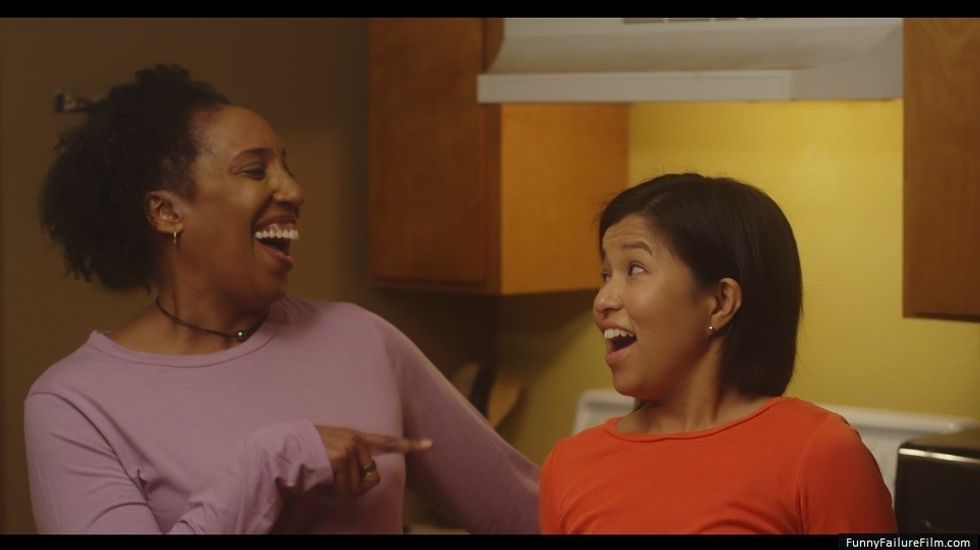
Deniese D.B. Garner and Karla Acosta in 'How to Successfully Fail in Hollywood'
Credit: Showstoppers
The fear of failing stops many artists in their tracks. But it’s the process of failing that leads to the most innovative, interesting solutions and films. You simply must fail many times to achieve better results.
Failure has a social stigma, especially in the industry. Our film looks it dead in the eye and laughs. In speaking about the film, people and the press seem to have a keen interest in the failure aspects. It brings forth remarkable confessions (and laughter) around people’s own failures.
In fact, these stories inspired our How to Successfully Fail in Hollywood podcast as we invite and have artists share their slip-up stories on the show and insights they gained.
One filmmaker, Lisa N. Alexander, shared an entertaining story of when she and her husband (a camera operator) were hired for a reality show that went sideways. She mentioned they didn’t share the story with anyone for over a year because they were ashamed of the experience.
But, if the response to our film is any indication, failure is ultimately relatable. Who hasn’t fallen on their face? Experiencing failure also connects you to your humanity, a great asset as a filmmaker. Keep that in mind if you feel shame creeping in.
Multihyphenate silent film actress and producer Mary Pickford said, “Failure is not the falling down but the staying down;” and George Burns shared, “I'd rather be a failure at something I love than a success at something I hate.”
There’s a reason a film’s production budget has a line item called Contingencies. This category was created with the wisdom that things don’t go as planned often enough, it needs to be built into the plan. So, always keep a plan B, C, and D at the ready.
Finding humor in a situation is not only fun, it’s quite practical and freeing. It allows for some perspective and seeing with new eyes while developing the courage to try new things.
What remarkable film would you create, if you didn’t have the fear of failure?
This article is written by filmmaker C.M. Conway.
C.M. Conway (she/her) is the filmmaker of How to Successfully Fail in Hollywood. The diverse film about friends, fantasies and funny fails became the little indie that could, and now available on Prime Video. Due to the social value and positive response to the film, it’s been covered by numerous media outlets. Her new podcast on popular platforms is named after the film, and invites and shares the slip-up stories of artists of all trades. Her new screenplay Court(ship) currently in development, details how worlds collide on a jury between a liberal woman, a conservative man, and a medical case involving a queer woman of color. Visit FunnyFailureFilm.com for more information, links to the film, and podcast.- Why Did 2022 Fail to Represent More Women Behind the Camera? ›
- The Most Inspirational Steven Spielberg Quotes ›
- You Are Going to Fail at Filmmaking More Than You Succeed—How to Deal with It ›
- Disturbing USC Study Reveals Just How Badly Hollywood Fails Women and Minorities ›
- There’s Something in the Barn Score ›











